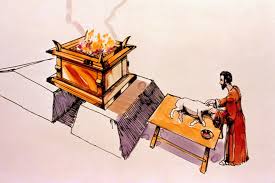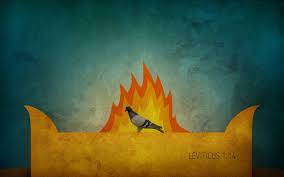The Burnt Offering
Exodus 29:38-42a; Leviticus 1:1-17 and 6:8-13
The burnt offering DIG: Beginning with Cain and Abel, why do you think God chose animal sacrifice to restore broken relationships? Couldn’t God forgive sins without sacrifice? Why do you think God demanded an offering without spot, defect, disease or deformity? Why the laying on of hands? Why sprinkle the blood? Why complete burning? How does the aroma pleasing to God foreshadow Christ (Ephesians 5:2; Philippians 4:18).
REFLECT: How would you define sacrifice? Does true sacrifice have to hurt? How do your sacrifices define your value system? For whom do you make sacrifices? What sacrifices have you, or can you, make for God (Romans 12:1-2; Hebrews 13:15)? In your experience, how has God reconciled you to Himself? By what sacrifice?
The burnt offering was a sacrifice from the herd, the flock, or an offering of birds, depending on how much you could spend. But since everyone was equally guilty of sinning, from the high priest to the common person, each would make an offering. It was usually preceded by a sin and/or guilt offering, and was voluntary for private sin, but mandatory for public sin. The sacrifice was to have no spot, blemish, disease or deformity. It was distinct from all the other scarifies, because except for the skin of the herd and the head of the bird, it was totally consumed. And as such, was an expression of total devotion, commitment and surrender to God.
After sin had been confessed and put away through the sin offering and the guilt offering, then the offender brought his burnt offering to the Tabernacle. Christ is our burnt offering today. Because we have put our faith in His sacrifice for us, the Father sees us washed of all sin and cleansed white as snow (Isaiah 1:18). All our imperfections and guilt are now hidden forever from His sight, covered by Messiah’s shed blood. Having identified ourselves with Jesus by faith, we must leave to Him the priestly work of sprinkling His precious blood, as it were, against the bronze altar on all sides, presenting His burnt offering to ADONAI on our behalf.541
Explicitly, the Burnt offering is mentioned in the New Covenant in Mark 12:33 and Hebrews 10:6-8, but implicitly, it is seen in Luke 2:23-24 and 17:14.
The burnt offering comes from the Hebrew word alah meaning to go up, because in this case the whole offering went up to God in smoke. This is the oldest of the five offerings, already found in Genesis 8:20-22. ADONAI called Moses and spoke to him from the Tent of Meeting (33:7-11). He wanted Moses to speak to the Israelites and say to them: When any of you brings an offering to ADONAI, bring as your offering an animal from either the herd, the flock or birds (Leviticus 1:1-2). The offering needed to be costly. The rich man had to give more than the poor man. What he brought to sacrifice was determined by his economic status, and a progression of the most valuable to the least valuable, from the herd, to the flock, to the bird, is seen.

If the offering was a burnt offering from the herd, the worshiper was to offer a year old male without spot, blemish, disease or deformity. Regardless of category, the offering had to be ceremonially clean, usable for food, and domesticated. Wild game was not permissible for sacrifice. He presented it at the gate to the Tabernacle, for the purpose of temporarily covering his sin. The guilty laid his hand on the head of the burnt offering as a means of identification (as well as confession and prayer). As he identified himself with the sacrificial, he symbolically transferred his sin to the animal, emphasizing the concept of substitution. Life for life. And the result was that it would be accepted on his behalf to make atonement for him. It freed the worshiper from the consequences of sin and protected him from God’s wrath. That is why the offender personally slaughtered the young bull at the north side of the bronze altar before ADONAI, making sure all the blood was drained. Then Aaron’s sons, the priests, brought the blood and sprinkled it against the altar on all sides. The worshiper skinned the burnt offering and cut it into pieces. Then the priests arranged the pieces, including the head and the fat, on the burning wood. After washing the inner parts and the legs with water, he burned all of it on the altar except for the skin, which was his portion (Leviticus 1:3-9).
If the offering was a burnt offering from the flock, from either the sheep or the goats, the worshiper was to offer a male without spot, blemish, disease or deformity. There was a division of labor when the offering was made, the priest had certain duties and the worshiper had certain duties. The guilty laid his hand on the head of the offering, symbolically transferring his sin to the animal, and then he slaughtered it at the north side of the bronze altar before God. Then Aaron’s sons, the priests, sprinkled its blood against the altar on all sides. The worshiper cut it into pieces, and the priest arranged them, including the head and the fat, on the burning wood that was on the altar. The priest washed the inner parts and the legs with water to remove all the excrement, and the priest burned all of it on the altar, except for the skin he kept (Leviticus 1:10-13).

If the offering to God was a burnt offering of birds, he was to offer a dove or a young pigeon. The small size of the bird required a simplification of the sacrificial ritual, so the priest did everything. He brought it to the bronze altar, wringing off its head and burning it on the altar; its blood was drained out to the last drop on the side of the altar. The crop with its contents were thrown aside on the ash pit and then the bird, which had been partially torn open, was burned on the bronze altar.542 It was a burnt offering, an offering made by fire, an aroma pleasing to ADONAI (Leviticus 1:14-17). The phrase pleasing to ADONAI, literally meant smelling of rest. It emphasized God’s approval and acceptance of the sacrifice. Like Abel’s sacrifice (Genesis 4:4), God looked with favor on the Israelite who brought a burnt offering.
The total devotion, commitment and surrender to Messiah is seen in the fact that the fire was to be kept burning continuously. It was to continue burning on the bronze altar throughout the night, till morning, twenty-four hours a day, even when traveling in the wilderness. It could not go out. The priests were to offer one-year-old lamb on the bronze altar in the morning and another at twilight. This spoke of the fact that the people needed a constant reminder that someone was needed to take their place and that their sin merited death. There had to be the shedding of blood for sin.543 Every morning the priest was to add firewood, arrange the burnt offering on the fire and burn the fat of the peace offerings on it. This was considered one of the five key duties of the priesthood. The first lamb was offered with a tenth of an ephah of fine flour mixed with a quarter of a hin of oil from pressed olives, and a quarter of a hin of wine as a drink offering. Thus, the daily offerings contained the basic parts of the people’s daily diet: meat, flour, oil and wine.544 The second lamb, sacrificed at twilight, was offered with the same grain and drink offerings as in the morning. After the morning sacrifice, the priest put on his white linen clothes, with linen undergarments and removed the ashes of the burnt offering that the fire had consumed on the bronze altar and placed them beside the altar. Then he took off his priestly linen clothes and put on regular clothing and carried the ashes outside the camp to a place that was ceremonially clean (Exodus 29:38-41; Leviticus 6:8-12).
For the generations to come, the burnt offering was made continuously on the bronze altar at the entrance to the Tabernacle before ADONAI (Exodus 29:42a; Leviticus 6:13). Israel was to be reminded day after day, year after year, century after century, that a holy God would accept them only on the basis of the sacrifice of the promised Savior, who was to offer Himself without blemish or defect. Thank God! The fire went out over two thousand years ago. Never again would our Savior suffer.545 Having made one offering, sufficient for all time, He sat at the right hand of God, because His work was finished (Hebrews 10:11-12).
The reason that we need to be totally committed to God today is seen in this: While we were still sinners, Christ died for us (Romans 5:8). We were spiritually dead and unable to make the first move toward God, because we inherited Adam’s sin nature that rebelled and separated us from Him. So God made the first move toward us by sending His one and only Son to die in our place for the payment for our sin. We stand before Christ, guilty of sin, and facing a death penalty. But Jesus, as judge (John 5:27), comes down from behind the seat of judgment, takes off His judicial robe and stands beside us. It is there that He says to us, “I will take your place. I will die for you.” And if you were the only person in the world, He still would have died for you. The penalty for sin is death, but Christ died and paid for sin so we do not have to go to hell.546



Leave A Comment